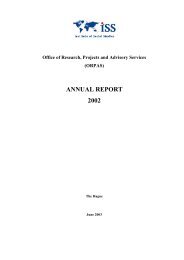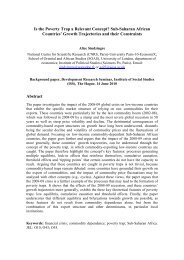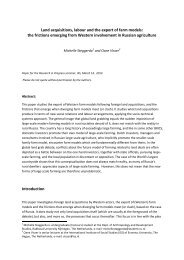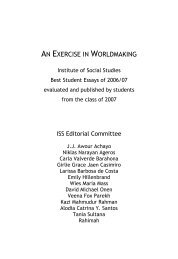AN EXERCISE IN WORLDMAKING 2009 - ISS
AN EXERCISE IN WORLDMAKING 2009 - ISS
AN EXERCISE IN WORLDMAKING 2009 - ISS
You also want an ePaper? Increase the reach of your titles
YUMPU automatically turns print PDFs into web optimized ePapers that Google loves.
17 Intersectionality and Human Rights: Law, Theory and Praxis 201<br />
white, middle-class interests, thus concealing the fact that the identity<br />
and social positioning of Native American women result in a different<br />
experience of domestic violence. The voices of these women are silenced,<br />
thereby disguising the need for discourses and services which<br />
appropriately address diversity.<br />
SOCIAL EXCLUSION <strong>AN</strong>D HUM<strong>AN</strong> RIGHTS THEORY <strong>AN</strong>D PRAXIS<br />
Intersectionality (as a concept) has much to offer human rights theory<br />
and praxis, particularly at the international level. The current fragmentation<br />
of conventions and human rights instruments such as treaties and<br />
treaty bodies, as well as humanitarian organisations and other role players,<br />
is due to their attempts to address one “problem” at a time. Thus,<br />
we have a multiplicity of human rights conventions, with each treaty addressing<br />
one particular issue, such as racism, gender discrimination and<br />
women’s rights, child rights, refugees, and more. People are not onedimensional,<br />
however. A woman is not only a woman – she is positioned<br />
(and she positions herself) in multiple identities of race, ethnicity, class<br />
and sexual orientation, among others. For example, women’s experiences<br />
of racial or ethnic discrimination often differ radically from those of<br />
men.<br />
In addition, despite all these instruments, human rights violations occur<br />
on a daily basis – in homes and places of work, in prisons, and so on.<br />
While human rights (in both theory and practice) can be used creatively<br />
and effectively, some have argued that this “impressive regime of laws<br />
do not protect women” (Murungi 2002: 33). There is some truth to this.<br />
Both human rights law and practice treat human beings as though we<br />
have linear identities. The reality of structural intersectionality means that<br />
we need instruments and theories which deal appropriately with the<br />
complexities of being a human being and the continuities of socially constructed<br />
identities, which are multiple and relational. Intersectionality, as<br />
a concept, offers us this potential. Human rights instruments, such as<br />
international treaties, as well as interventions in conflict situations, can be<br />
strengthened, improved and made more effective through the application<br />
of intersectionality.<br />
The realities of intersectionality are lost among our attempts to categorise<br />
– people, experiences, data, almost everything. These categories,<br />
and the resulting linear identities they create, are neat and relatively easy<br />
to work with. The application of the law is made less complex if we
















